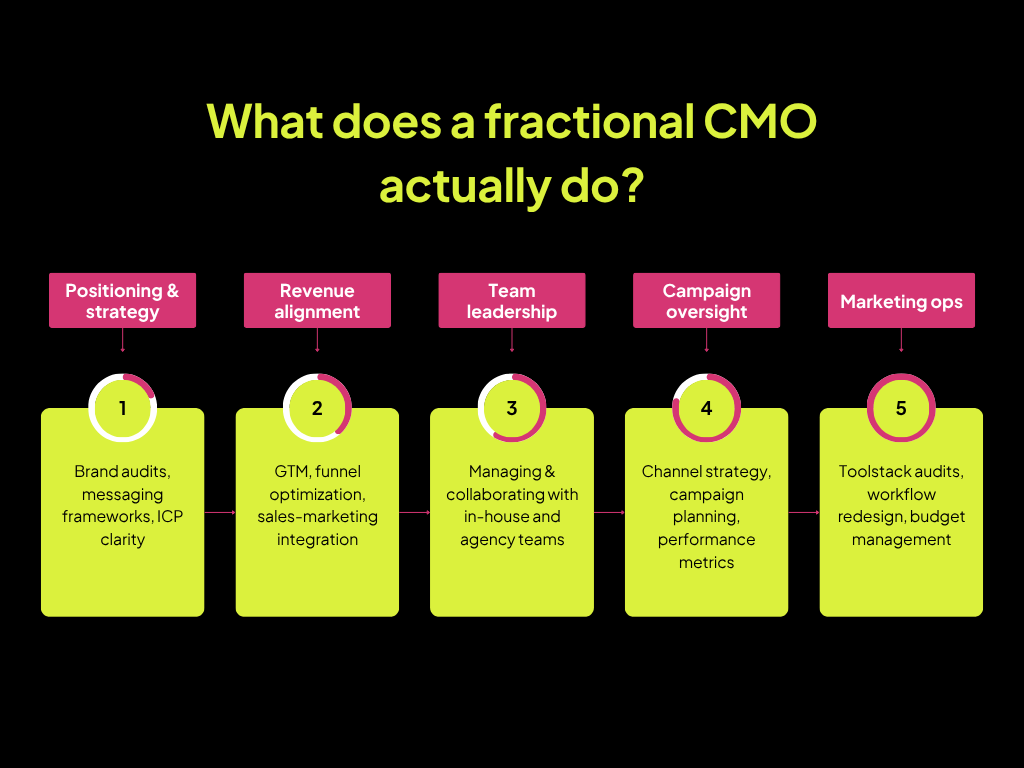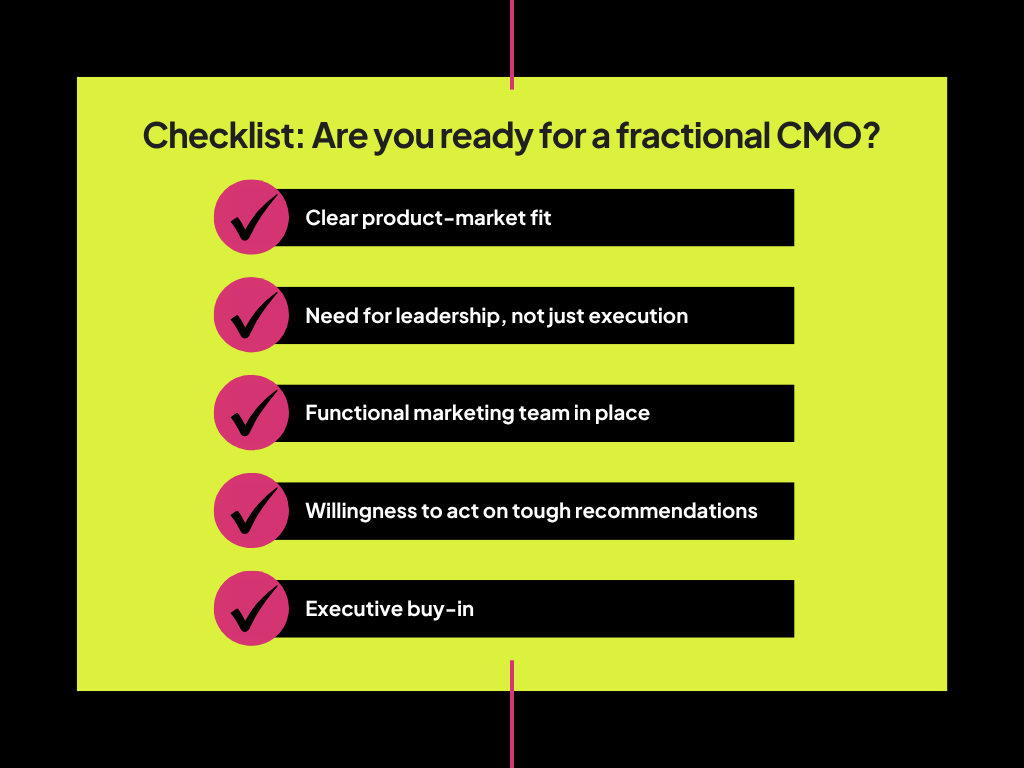B2B marketing has never moved faster or felt more fragmented. As the pressure to deliver outcomes increases and internal teams juggle strategy, execution, and measurement, many brands are turning to a new kind of leadership: the Fractional CMO.
This guide answers every key question B2B decision-makers have about Fractional CMOs—what they do, when to bring them in, and how to know if your company is ready.
What is a fractional CMO?
A Fractional Chief Marketing Officer is a senior marketing leader who works with your company on a part-time or project-specific basis. Unlike traditional full-time CMOs, they plug into your business flexibly, owning outcomes, shaping strategy, and leading teams without the overhead of a full-time hire.
Fractional CMOs are particularly valuable for:
- Early-stage companies that need senior leadership but aren’t ready for a full-time CMO.
- Scaling brands that need a specialist to unlock growth levers.
- Mid-sized firms navigating transitions—fundraising, market expansion, rebranding, or product pivots.
Why more B2B brands are choosing fractional CMOs?
It’s not just a budget-friendly option—it’s a smarter way to work. Here’s why the model is gaining traction:
- Outcome-first leadership: Fractional CMOs align around business results, not vanity metrics.
- Speed to strategy: With experience across sectors, they accelerate strategic clarity and go-to-market execution.
- Cost efficiency: You get CMO-level expertise at a fraction of the cost.
- Cross-functional leadership: They bridge gaps between product, sales, marketing, and customer success.
At Tailwind, we’ve seen B2B brands unlock faster growth, tighter brand positioning, and smarter funnel performance—all without hiring full-time.
When is the right time to hire a fractional CMO?
Not sure if you’re ready? Here are some common triggers:
- Your team is busy, but impact is flatlining. Campaigns are running, content is shipping, but pipeline velocity is stagnant.
- You’ve outgrown your current marketing lead. Internal managers can execute but struggle to lead the big picture.
- You’re entering a new phase. This could be fundraising, international expansion, product diversification, or M&A.
- Your brand lacks clarity. Positioning feels inconsistent across channels, teams, and stakeholders.
- You need accountability. You want someone to connect the dots between GTM, brand, and revenue.
What does a fractional CMO actually do?
A good Fractional CMO isn’t just a consultant. They own the outcome.

The exact role depends on your growth stage and challenges, which is why engagement models matter.
Use cases and engagement models
Not all brands need the same thing. At Tailwind, we offer multiple engagement models based on where your business is today:
1. Fractional CMO
Ideal for: Companies that need a steady hand to own strategy + marketing leadership
- Duration: 3–6 months minimum
- Scope: Strategy, team management, executive reporting
2. Project-based
- Ideal for: Brands needing a short-term sprint—e.g., product launch, rebrand, category entry
- Duration: 4–12 weeks
- Scope: Messaging frameworks, campaign roadmap, playbooks
3. Advisory model
- Ideal for: Founders and Heads of Marketing who need strategic oversight
- Duration: Monthly/Quarterly check-ins
- Scope: GTM critique, org design, performance reviews
More on engagement models: What are the Engagement Models of a Fractional CMO—and How Do They Work?
What key benefits do companies see?
Fractional CMOs don’t just save costs—they unlock growth levers. Here’s what companies experience:
- Faster clarity on what’s working and what’s not
- Clearer messaging and sharper positioning
- Improved CAC:LTV ratio through smarter funnel design
- Leadership bandwidth freed up to focus on growth
- Reduced team churn through better org design and accountability
How AI is changing the game—and the role of the fractional CMO?
Marketing is being redefined by AI, automation, and signal intelligence. A modern fractional CMO doesn’t just bring frameworks—they bring systems thinking.
At GAINTAILWIND, we build AI-native marketing engines. That means:
- Automating routine decisions across media and content
- Integrating LLMs into content workflows
- Building dashboards that track business, not just channel KPIs
- Designing martech stacks that actually talk to each other
In an AI-first world, the right marketing leader isn’t just creative. They’re operationally intelligent and automation-savvy.
Questions to ask before onboarding a fractional CMO/team
To ensure fit, clarity, and alignment, here are 6 questions we recommend asking:
1. What business outcomes have you delivered in past B2B roles?
2. How do you balance strategy with execution?
3. What engagement model do you recommend for our stage?
4. How do you approach team and agency collaboration?
5. What tools, systems, and dashboards do you typically use?
6. Can you share examples of brand or funnel transformation work?
Final word: Don’t hire for activity. Hire for impact.
A Fractional CMO isn’t a freelancer or a glorified consultant. They’re a growth partner who helps you move from scattered activities to business-aligned marketing engines.
Whether you’re early-stage and resource-strapped or mid-sized and transformation-ready, bringing in a Fractional CMO could be the move that resets your trajectory.









